Mansion of the Weird
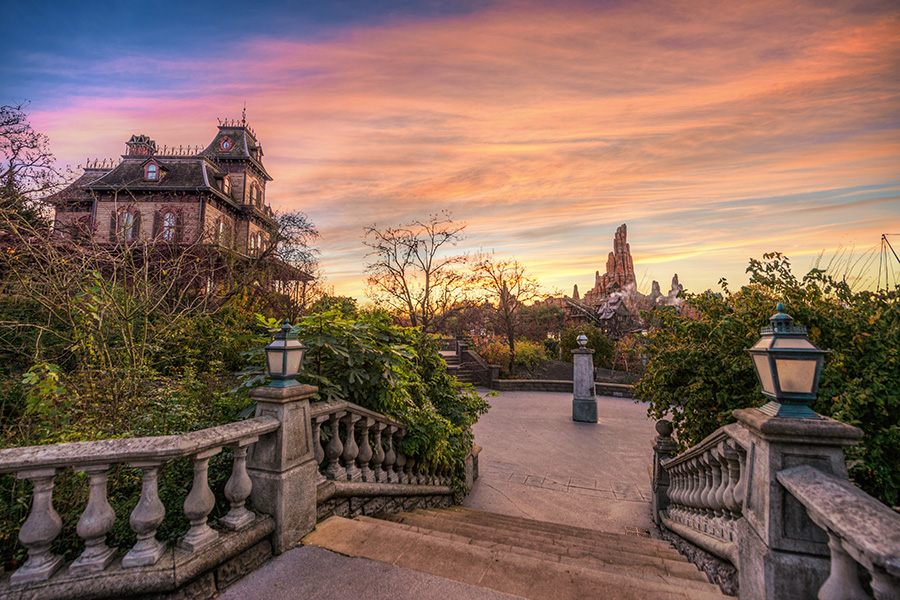
Since 1992, the ghostly grounds of the Ravenswood Estate have been a sort of Mecca for fans of Walt Disney Imagineering. Phantom Manor – the last “Haunted Mansion,” if indeed it is one – is a must-see ooddity. Though built on the backbone of the Haunted Mansion, much was added (and lost) in translation, yeilding a product that feels stretched and squashed; reinvigorated, but colorless; reinvented, but an emulation of something else; something better.
All said, there’s one facet of Phantom Manor that rises above the rest: its weirdness.

Think about it: for all that fans tend to decree that Phantom Manor is the story-rich counterpart to the plotless Haunted Mansion, a Devil’s advocate might ask, “Okay… So what’s the story?” No different from Haunted Mansion, it’s clear that the pieces of a connected narrative were present when Phantom Manor opened its gates in 1992, but to suppose that it’s a clear one with a beginning-middle-and-end takes a whole lot of filling in the blanks (which we’ve attempted to do to some avail).
Foxx Nolte’s Boundless Realms notes, “What we have left is the sort of thing you can argue over drinks, but never really comprehend because Phantom Manor doesn’t give you the necessary information to decode and make logical most anything that happens.”
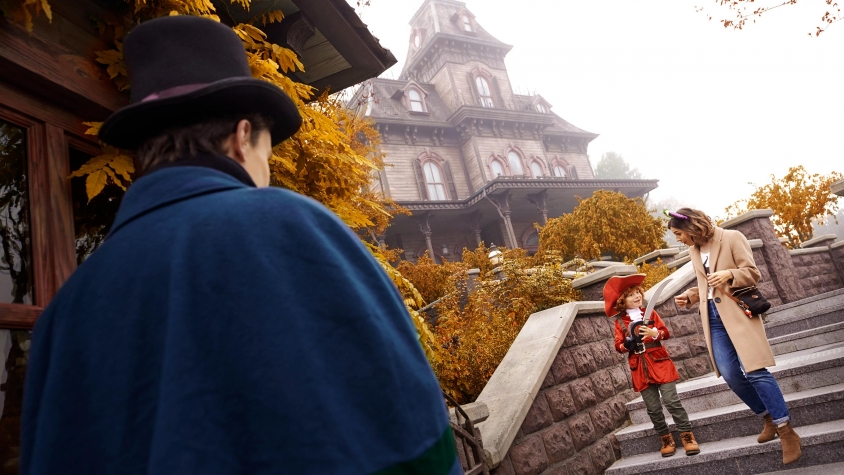
Narratively, it also places guests into an odd role: that of an unaffected observer. For all the guessing it takes to decode the embedded narrative, the end result seemed – at best – to be a silent film playing out between the Phantom and Bride – darkness and light incarnate. Guests aren’t even “playing themselves” as in the Haunted Mansion; they’re merely riding through a tale unfolding between archetypical characters with few specifics. Our “stretch” – to imagine guests trapped in a time loop, personifying the two characters’ few seeming direct glances at riders as intentional interventions – might help flesh it all out, but it’s still, fundamentally, a passive experience.
At best, a guest’s role might be to solve a puzzle with no end. After all, Phantom Manor thrives on its mystery. Ask any Disney Parks enthusiast, “Who is the Phantom?” and you’ll find that the dead ends of Phantom Manor’s mythology serve as its weakness and a source of wonder.
A ghoulish reimagining
In 2015, Disneyland Paris formally launched “Project Sparkle,” a mea culpa initiative meant to revisit and reinvigorate a number of the park’s opening day attractions. After all, though Disneyland Paris is celebrated for its ambitious art direction and storytelling, few would accuse the park of being well-maintained or cared for.
It’s not just that the park’s last major addition was the fantasy-infused Lost Legend: Space Mountain in 1995 – twenty five years ago. It’s that Disneyland Paris’ standards for refurbishments and upkeep famously fell behind during the resort’s massive financial crisis, and have arguably continued since thanks to focus on the underbuilt Studios park next door.
As part of the much-needed refreshing of the park, Phantom Manor closed its gates in January 2018 for an unprecedented year-long refurbishment. Early on, Disney Imagineers reported that the ride would receive a number of upgrades and enhancements, infusing the 1992 original with modern Imagineering embellishments. Fans expected tools like projection mapping and advanced Audio-Animatronics to be part of the mix.
Some reported that the “refreshed” Phantom Manor would be ready by Halloween 2018. But the Manor remained dark. Christmas passed, too. In fact, the ride’s planned 11 month haitus extended to sixteen months. When the Ravenswood estate re-opened on May 3, 2019, some significant changes awaited within… More than just light and sound upgrades (though they’re plentiful), Imagineers solved several of Phantom Manor’s more elusive mysteries… and then created several more.

Now, guests enter the Manor by way of a decaying foyer where once-vivid wallpaper has peeled exposing rotting wood. Presiding over this sunlit transition space is a mottled portrait of the Bride with her father standing behind, steely eyes forward and hands controllingly gripped on his daughter’s shoulders.
The creaking narration of Vincent Price – restored at last alongside Chevalier, making the ride’s pre-show bi-lingual as the two voices alternate – offers that “Beauty once lived in this house.” Color and life supernaturally return to the painting, spreading through the room as it’s restored to its former glory. It’s a haunting and overt introduction free of the subtlty and spookiness of the Haunted Mansion and instead a clue that Imagineers have gone to greater lengths to unspool the threads of Phantom Manor’s story at last.
Which isn’t to say 2019’s “revealed” story isn’t without its controversies.

For example, while 1992’s Stretching Room had introduced the Bride as a victim of supernaturally sour luck (and perhaps hinted at a spurned, risen estate caretaker as a spiteful source of the Phantom’s grudge against the family), today those portraits have changed… Each shows Melanie paired with a suitor. As the room begins its “disquieting metamorphosis,” Melanie herself flickers out of each painting, leaving her doomed loves to unspeakable ends…
Is Melanie the subject of a curse dooming every man she loves, with our ride through Phantom Manor merely retelling the tale of her final fiancé for whom she still waits?
Or is the pattern of lost lovers and Melanie’s “lucky” escapes from peril more than a coincidence? That is, could the Bride herself be involved in the darkness of Phantom Manor? It’s a question compelling enough to add an asterisk to the simplistic “dark versus light” narrative fans thought they knew… and the plot only thickens…

If you – like many Disney Parks enthusiasts – felt that the identity of the Phantom was left intentionally vague (Is it the bride’s cursed fiancé? Her controlling father? A spurned estate caretaker who wants Melanie for his own? A scorned Big Thunder Mountain miner whose vengeful spirit is intent on ending the family line? The Thunderbird incarnate, merely enacting a mystically-instigated coup against the Ravenswood family who dared invade sacred lands?), 2019’s reimagining might not leave you pleased.
In the Portrait Gallery leading to the Grand Hall, paintings are transformed by each flash of lightning. And at least in the case of the Phantom’s identity, the supernatural storm seems to have revealed the answer: it is, indeed, Mr. Henry Ravenswood himself whose abusive oversight of his daughter has lead to his maddening control over her, even in death.
The Haunted Mansion’s slow reveal of the supernatural is enough to cause guests to ask, “Am I seeing things?” Phantom Manor – as we discussed – has never played coy. But now, the mournful figure of Melanie makes her first “in person” appearance before guests even step on aboard. The Bride looms atop the Grand Staircase, gazing out across Thunder Mesa in the midst of a gullywasher.
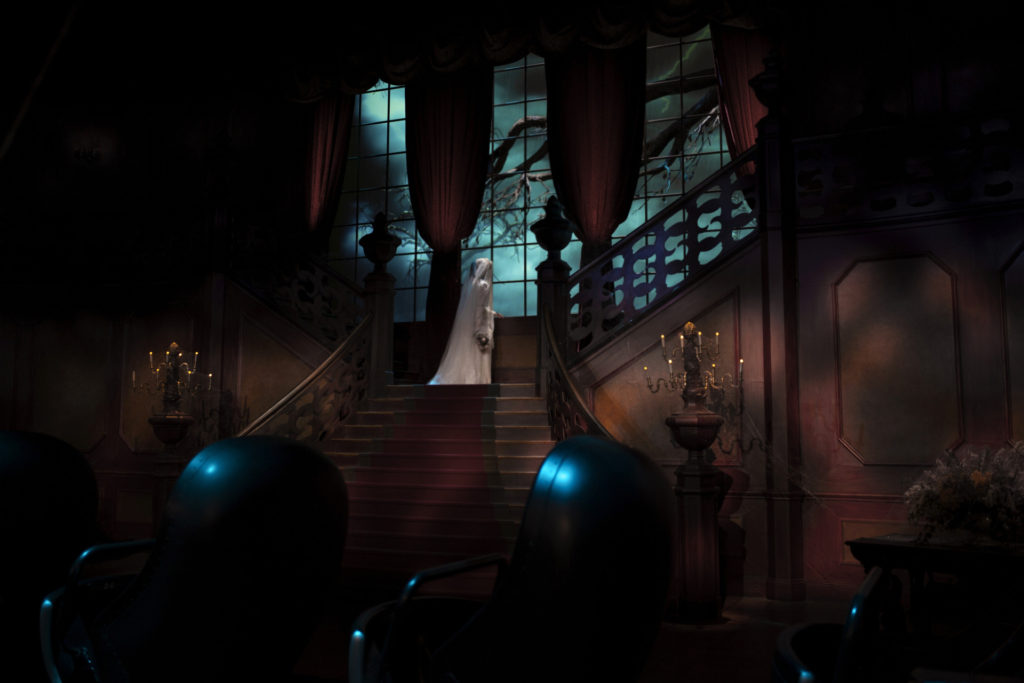
And now – with the identity of the Phantom seemingly revealed – the apparition makes numerous new appearances. Cleverly, Imagineers also changed the Phantom’s role in some subtle but important ways… Rather than a harbinger of despair and gloom, the Phantom has taken on a new form: a red-eyed spirit ever looking over Melaine’s shoulder. He’s present in the Endless Hallway now, turning the eerie introduction to the Bride into her hopeless attempts to escape him…
Think of what a narrative departure that is. Since 1992, fans had “filled in the blanks” of Phantom Manor, suggesting that the Bride was a tragic hero; purity incarnate, forever mourning her lost love while –practically unbeknownst to her – the vengeful spirit responsible for his death watches from afar, cackling. We even watched as – throughout the ride – Melanie and the Phantom seemingly decayed before our eyes, both as mere rotting corpses by the ride’s finale wherein the Bride’s last gasp is a heroic sacrifice saving us from being drawn into the dread and heartbreak she relives each day.
We mused that, in looking into that mirror frosted over with the face of death, Melaine was mourning the notion that she’s be alone forever.
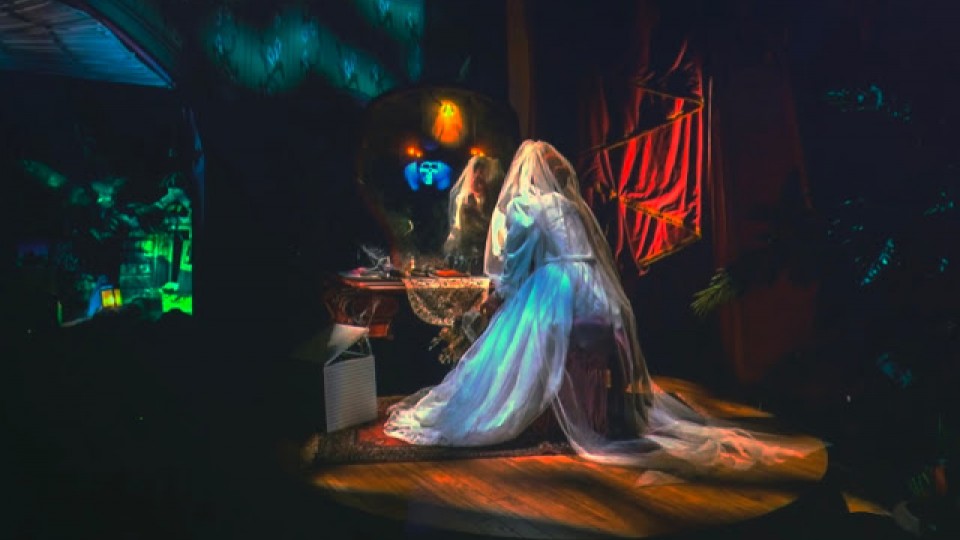
But what if the truth is that the Bride was mourning that she’d never be alone?
After the 2019 reimagining, our visit to the Bride in her boudoir has a subtle (but substantial) change. As we circle ’round the sobbing beauty, we see the cause of her concern: visible only in the mirror, the Phantom is still there… Unshakable. What if we’re finally seeing what’s haunted her all these years; what if the cause of Melanie’s sadness isn’t her lost love, but the stalking Phantom, always over her shoulder in every mirror she glances into? What if Melanie is burdened not by heartbreak, but by terror and guilt?
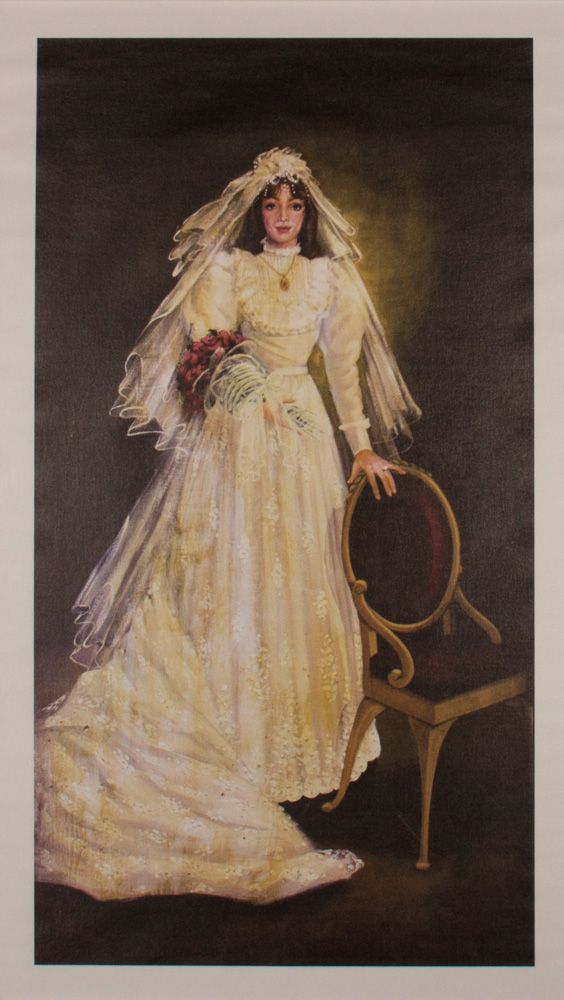
Maybe Phantom Manor was never the story of a decaying beauty, a defiled purity, and a naive, innocent Bride awaiting her lost love. Maybe it’s the story of a crazy woman haunted by the (literal) ghosts of her past who kills herself in her madness, her own spirit haunting these grounds and gradually being infested with the darkness of guilt and fear?
Non omnis moriar. “Not all of me shall die.”
As the carriages continue through a relit Phantom Canyon scene, the familiar ending approaches: the redressed Phantom, cackling as he directs us back toward the house on the hill. But now, where Melanie’s rotting corpse had once seemed to save us from being resorbed into her tragic tale, there now exists something different. In place of the “Hitch-Hiking Ghosts” adaptation that had placed the Phantom in our carts with us, now we’re visited by a white-eyed, unhinged bride who offers in an eerie, childlike voice, “Will you marry me?”
To be sure, the radical departure from the ride’s longstanding finale left Imagineers fans with a single question: “What?!”
Dead ends

Even on re-ride after re-ride, it would be difficult to become convinced that the tragic, operatic beauty who mournfully weeps to an orchestral score would pivot so drastically in the final seconds of the ride. Even if 2019’s reorchestrated pre-show suggested that Melanie might have a role in the disappearances at Phantom Manor, the new finale doesn’t leave even an iota of subtlty. It literally insists that Melanie has become that most tried-and-true of Disney Haunted Mansion archetypes: a black widow bride…
Reception to 2019’s “reimagining” of Phantom Manor has been… mixed. Particularly, it’s easy to see how the (literal!) last minute repositioning of the Bride literally shocked fans of the park. For decades, Melanie had been an unofficial icon of Disneyland Paris; a character created just for the park; a tragic candlelit figure fighting against the darkness of Phantom Manor. And admittedly, no matter how deep you’re willing to look into the idea that some subtle changes hint as a very different underlying characterization for the Bride throughout, the truth is that even the most liberal interpretation would call that final plot twist abrupt.
While most of the changes to the ride range from widely agreeable to obvious, such a radical reinterpretation of one of the ride’s central characters has certainly been hard for Imagineering fans to swallow. Do us a favor – take a ride through the “reimagined” Phantom Manor below and keep an eye out not just for the fresh effects, but for those subtle – but substantial – edits to the tone and mood that many Disney Parks fans resent:
So wait… Was Melanie “in on it” from the start? Was it she – and not her protective father – who put an end to those would-be husbands introduced in the new Stretching Room? If so, that would undo much of the mythology fans had believed for decades!
Or was Melanie indeed a naive innocent, merely driven mad by the loss of one too many loves, self-barricading into her dead family’s cursed estate where the Phantom’s noxious spirit led to her death and her eventual decay into darkness?
How does the tragic, mournful hero fans thought they knew for decades blend into a ride that ends with a possessed Bride seeking new suitors to murder? And for that matter, who’s the villain of Phantom Manor: the Bride, the Phantom, or both?
The answer – like so much of Phantom Manor – is probably that there is no answer. More than likely, the best way to understand the oddities, inconsistencies, and disconnections of Phantom Manor is probably just to admit: it’s weird.
Modern Marvel

Long, long ago, Walt Disney and his Haunted Mansion were inspired by the Winchester House – that sprawling complex of oddly interconnected rooms, stairs that terminate in ceilings, windows in the floors, doors into drop-offs, and dead-ends galore. In some ways, Phantom Manor might be the best narrative embodiment of that inexplicable floorplan.
Try as fans might, there’s just no way to untangled the threads of Phantom Manor. It’s both simplistic and complex; familiar yet foreign; romantic yet tragic. It’s a messy mix of dead-ends, adaptations, allusions, and oddities that’s whispered about – for many reasons – in fan circles. And why not? Imagineers’ attempts to infuse the Haunted Mansion with a heartbreaking tale absent any “grim, grinning ghosts” or joyful singalong finales was a bold and brash reinvention that served in many ways as the icon of Disneyland Paris and its romantic reimagining of what Disneyland should be.
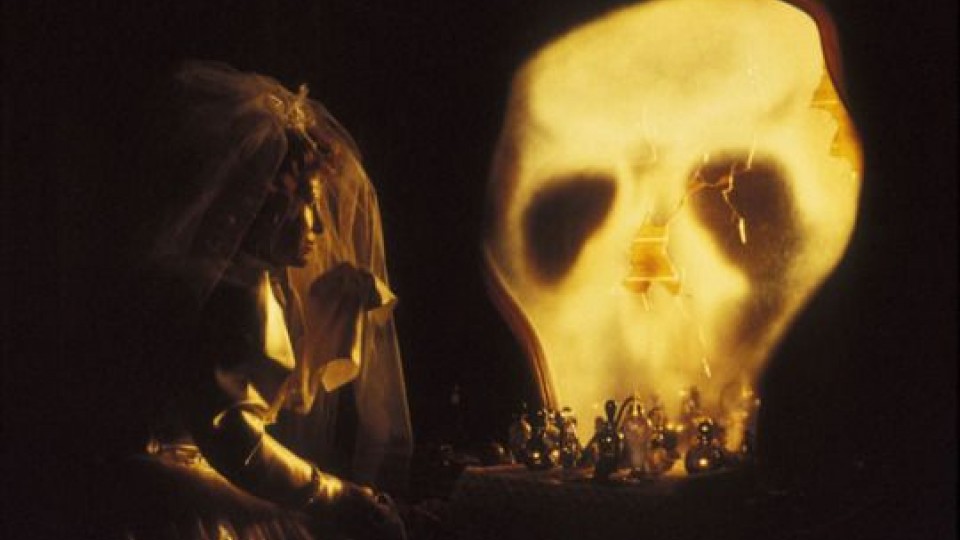
Phantom Manor dared to tackle the unthinkable act of looking at a Disney Parks classic differently. In equal parts, it’s renowned and reviled for its attempts. It’s a Haunted Mansion born of the “Ride the Movies” era; a product inseparable from the “extended universe” of Thunder Mesa and the fantasy-infused Disneyland Paris it resides within; a “spiritual sister” that feels so different from the original ride that’s ostensibly its near-identical twin.
As for the “dead ends,” “doors to nowhere,” and “stairs into ceilings” that are all too present in the “story” of Phantom Manor? The answer – like so much of the ride – is probably that there is no answer. More than likely, the best way to understand the oddities, inconsistencies, and disconnections of Phantom Manor is probably just to admit: it’s weird! And like it or not, weirdness is something we’d sure like to see more of from Walt Disney Imagineering today.
But now, we want to hear from you. Phantom Manor may be unusual, but it also defies so much of what the Haunted Mansion held dear! What do you think? Would Walt hate the ride’s decrepit and run-down exterior? Is the Haunted Mansion less re-ride-able when it has a more concrete story with a beginning, middle, and end? Did Disney’s strange changes to the bride’s role in 2019 alter the ride beyond recognition?
How would you feel if it were announced that Phantom Manor would “replace” Disneyland or Magic Kingdom’s Haunted Mansion for good? We can’t wait to read your thoughts in the comments below!

Thank you so much for reading. Now, it’s your turn to join the story. If you enjoy spending time falling down the “rabbit hole” of Park Lore’s in-depth, ad-free, member-supported stories, consider becoming a Member for as little as $2 / month.
Members can unlock rare concept art in every tale, reveal attraction audio streams in select stories, gain access to over a hundred exclusive articles in our quick-read Extra Features and in-depth Special Features collections, gain exclusive podcast extras, and receive an annual member card and merch in the mail! (Plus, y’know, supporting research-based, ad-free, clickbait-free, in-depth theme park writing!)



